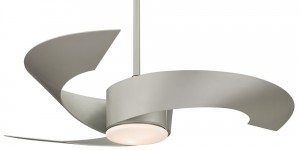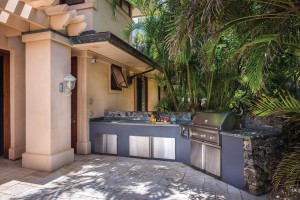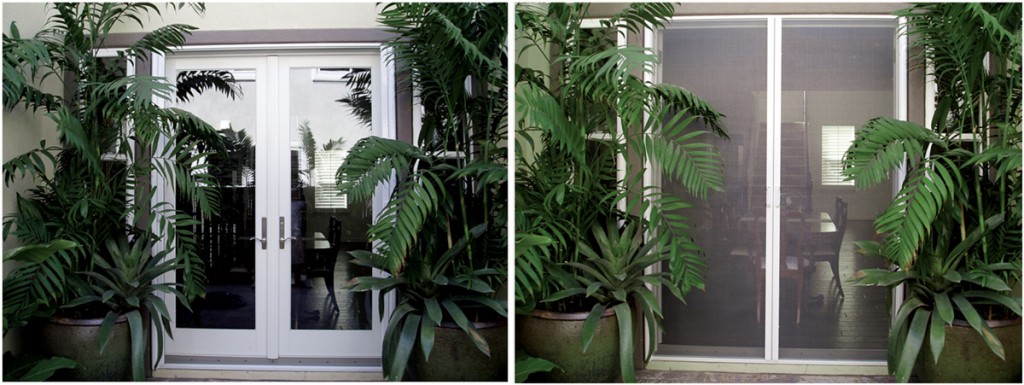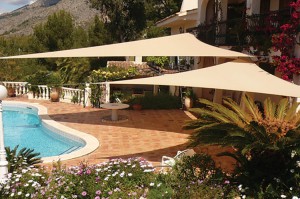How to keep your house cool and comfortable this summer.
 By Shelagh Duncan
By Shelagh Duncan
This seems to be have been one of our warmer summers and it gets harder to keep our homes cool. A/C is expensive and we all know it is better to breathe in the wonderful, oxygen-rich air that surrounds us than any ‘processed’ air.
I was just up in San Jose for a few days, and it was a fair bit cooler up there. There were some big breezes passing through—which were great—and helped make up for all the other stuff I don’t really love about big cities! Coming home, I was reminded just how humid and warm our little part of Paradise can be. This is not a bad thing—but we do need to be able to be as comfortable as we can in the heat, and maximize our enjoyment while living here.
To keep our homes cooler, here a are a few ideas:
 Outdoor Kitchens
Outdoor Kitchens
I have talked about this before, but this is a very practical option when you live anywhere warm.
Cooking can sure heat up a house pretty fast! Installing an outdoor kitchen can let you enjoy the ‘Joys of Cooking’ and also allow you to enjoy the outdoors, your dinner guests and keep yourself and your home cooler in the process. Even creating an outdoor grill center will keep a lot of that heat out of the kitchen.
If you don’t have an outdoor kitchen then use your microwave, or crock-pot whenever you can.
Fans
Okay, this sounds like a no-brainer but keeping a few key fans on in your home can make a big difference. Leaving them all on may not be necessary, depending on your particular home and where it is located. A turbo fan in the bathroom is great for quickly getting rid of the humidity after showers, and for helping get the towels dry too! If you are concerned that using the kitchen fan will make the food cold, install a wall mounted one that you can position specifically on the chef! Or get a small table top one that you can move around with you.
Ventilation
There are many important things to consider when building your home, but probably one of the most important is ensuring you have good cross ventilation. If the house is positioned well, you can catch both the morning and evening breezes when they change direction.
To help keep your house cool you can also add roof insulation, high ceilings and large overhangs to shade the walls and windows—but nothing can beat good airflow.
Most of us have a formal front door. It is nice to have an attractive entrance to your home, but the drawback is that when that door is closed it can shut off the airflow through the house. You could add a traditional North American screen/storm door, but let’s be honest—they are not very pretty and are the first thing you see when you come to the entry.

Another option is to use a retractable screen (visit Mirage Screens on FB). These are a great idea as they disappear when not in use and are invaluable for air-flow when open. They will allow the beauty of your front door to show, and when you need to let the breezes in (but keep the bugs out), they do the job perfectly!
Live outside
Before we came down here, most of us probably did not realize that in the tropics life is lived outside the house more than inside. So, create a comfortable lounge area outside on a terrace or rancho area, and position it such that you can enjoy it for most of the day—and evening. Use outdoor curtains or blinds to give you daytime shade when needed.
If bugs are an issue then special retractable screens can be used horizontally on wide openings too. Also, put some string-lights or mini-lights around the perimeter of your roof line. That will draw the bugs to the brighter lights outside, and keep them away from where you are sitting with dimmer lighting.
 Create Shade
Create Shade
Naturally where there is shade, the air will be cooler. I am an unapologetic tree-hugger, and I strongly believe that the more trees you have around your home the cooler they will keep it. If you are concerned about falling trees or limbs, get insurance from INS. They include that in their house owner’s policies.
You can create instant shade by using Shade Sails. They offer a very practical solution for creating shade exactly where you need it, including over your car, pool or patio.
Go Green
On a similar note, reduce the amount of concrete around your home by planting anything green. Concrete heats up in the sun, and retains that heat too. Replace it by planting native plants and shrubs around your house—they reduce the need for watering and they will reward you with beauty and shade.
Window Coverings
In rooms where you have the sun coming in and heating up the house, use window blinds or curtains to create that much needed shade. The best option is to use window coverings with special black-out lining. The sun will quickly fade upholstery fabrics and bedding, so protect your investments.
Reduce Electricity
When you see a little red glowing light staring at you in the middle of the night, remember that is still drawing power, costing you money and producing heat. Just turning an electrical device off is not enough. Unplug items not in use. Also, change your light bulbs to Florescent or LED. A traditional 100 watt light bulb can increase the heat by 11 degrees per hour in a small room!
Appliances with the Energy Star rating use less power (and create less heat), so when you need to replace an appliance keep this in mind.
Another no brainer is to keep the electric dryer for emergencies and rainy season drying. The one good use for all that tile or concrete around your pool is to sit your fold-up drying rack there to make the laundry dry faster!
When we have done all of the above and are still feeling the heat, there is always the pool or the beach to cool us off. Gotta love Costa Rica!
royalpalminteriors@gmail.com
www.royalpalminteriors.com
www.miragescreensystems.com/dealers/uvita-de-osa-puntarenas

